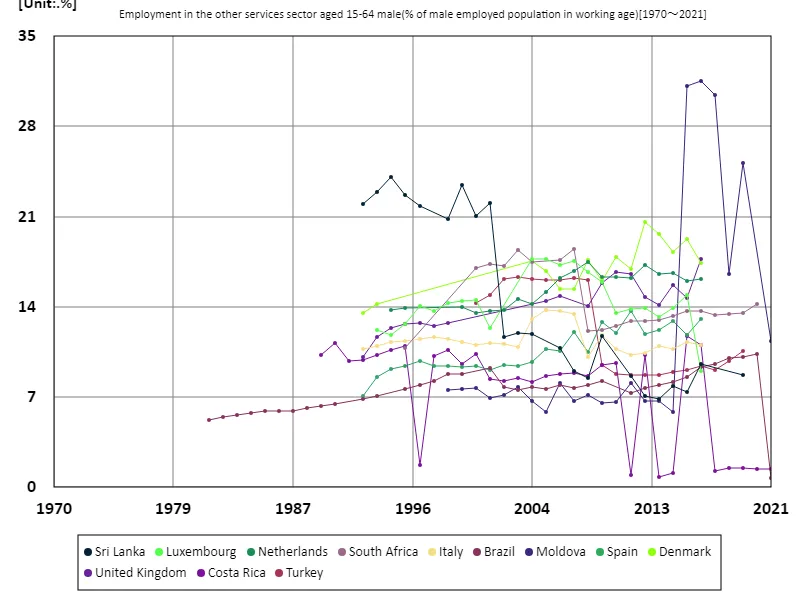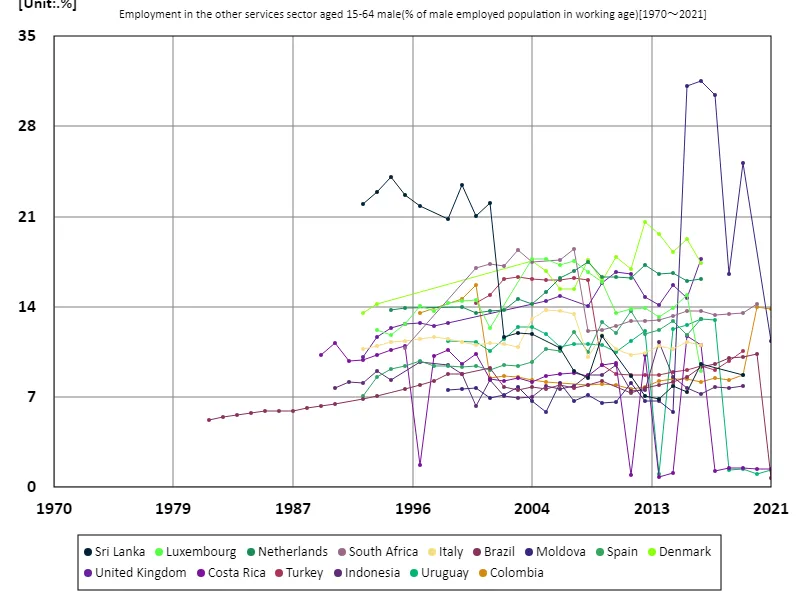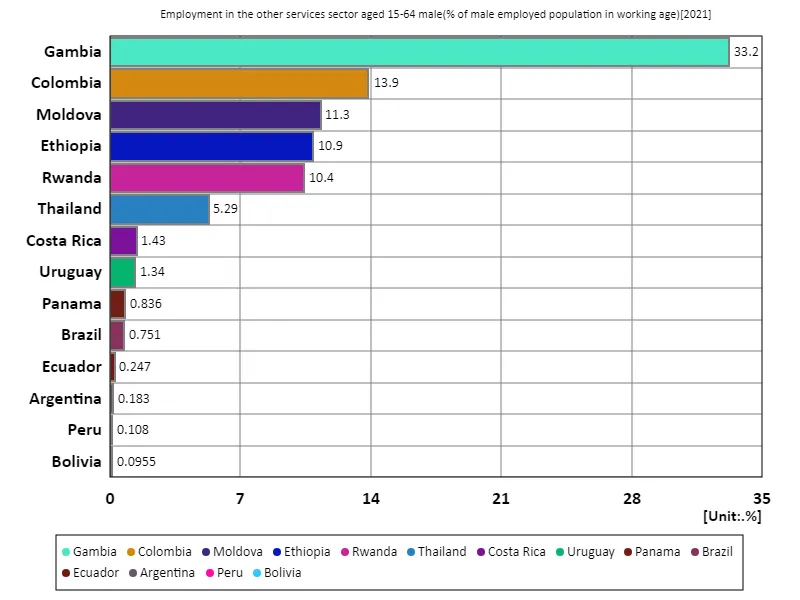- Abstract
- Employment rate for men aged 15-64 in other services sector (percentage of working-age males in the workforce)
- Employment rate for men aged 15-64 in other services sector (percentage of working-age male employed population) (Worldwide)
- Employment rate for men aged 15-64 in other services (percentage of working-age males in the workforce) (World, latest year)
- Employment rate for men aged 15-64 in other services (percentage of working-age males in the workforce) (region, latest year)
- Reference
Abstract
Moldova’s 2021 ”Employment rate of men aged 15-64 in other service sectors” of 11.3% indicates the employment rate of men in certain service sectors. This means that Moldova has a relatively high employment rate in the other service sectors. In general, developing economies tend to see growth in service sector employment, but this is often relatively low compared to other developed countries. In the case of Moldova, the expansion of employment opportunities in other service sectors is likely contributing to the high employment rate. The increase in employment rates may also be linked to a country’s economic growth and changes in its social structure, and in Moldova this trend indicates the growing importance of the service sector.
Employment rate for men aged 15-64 in other services sector (percentage of working-age males in the workforce)
Considering data from 1981 to 2021, Moldova’s “Employment rate of men aged 15-64 in other service sectors” shows a notable change. This indicates a significant increase in employment opportunities in Moldova’s services sector, particularly from a peak of 31.5% in 2016 to now reaching 35.9%. Historically, Moldova has seen a gradual increase in employment in the service sector, which is likely due to the growth of the service industry as well as the diversification of the economy. In particular, economic reforms over the past few decades and changes in the international economic environment have contributed to the expansion of employment opportunities in the service sector. This growth suggests that Moldova’s labor market is shifting from agriculture and industry to the service sector, and that the labor market is adapting to the advancement of the economy and changing social needs.


The maximum is 31.5%[2016] of Moldova, and the current value is about 35.9%
Employment rate for men aged 15-64 in other services sector (percentage of working-age male employed population) (Worldwide)
Based on data from 1981 to 2021, Moldova’s “Employment rate in other service sectors for men aged 15-64” has shown notable growth. In particular, it has risen from a peak of 31.5% in 2016 to 35.9% today, reflecting the growth and increasing importance of Moldova’s services sector. As the economy changes in Moldova, there is a shift from agriculture and manufacturing to the services industry, and employment is particularly increasing in the service sector. This trend reflects the diversification and internationalization of the economy and the changing labour market to meet society’s needs. The growth of Moldova’s services sector is contributing to economic development and the creation of new job opportunities, which can be attributed to the country’s economic reforms and the external economic environment. Overall, the rise in employment in the service sector is an important indicator of the changing structure of Moldova’s economy.


The maximum is 31.5%[2016] of Moldova, and the current value is about 35.9%
Employment rate for men aged 15-64 in other services (percentage of working-age males in the workforce) (World, latest year)
According to 2021 data, the highest “Employment rate of men aged 15-64 in other service sectors” in the world is Gambia at 33.2%, while the average is 6.43% and the total is 90%. The data shows diversity in the importance and size of employment in the services sector across countries. The Gambia’s high employment rate reflects the country’s economy’s heavy reliance on the service sector. In countries like The Gambia that are highly dependent on certain service sectors, service jobs may play a central role in the economy. Meanwhile, the relatively low average of 6.43% suggests that service sector employment is still developing globally. In many countries, agriculture and manufacturing remain the major sources of employment, with services accounting for a smaller proportion. The 90% total figure means that the majority of total employment is in the service sector, reflecting the maturity of the economy and the influence of the international economic environment. This highlights the important role that service sector employment plays in economic growth and structural change.


The maximum is 33.2% of Gambia, the average is 6.43%, and the total is 90%
Employment rate for men aged 15-64 in other services (percentage of working-age males in the workforce) (region, latest year)
According to 2008 data, the Central African Republic has the highest ”employment rate for men aged 15-64 in the other service sector” in manufacturing at 7.74%, while the average and total are also 7.74%. This uniform figure indicates that male employment in manufacturing is roughly comparable globally. The high figures for the Central African Republic suggest that manufacturing plays an important role in the country’s labour market. This trend reflects that manufacturing offers a degree of stability in creating employment opportunities compared to other industries. However, the overall figure of 7.74% is relatively low, indicating that manufacturing is not central to the economy in many countries. Manufacturing jobs are declining in developed countries due to mechanization and outsourcing, but are often growing in developing countries. The data shows that while manufacturing employment is becoming more equal globally, there are still differences across regions depending on their economic background and stage of development.


The maximum is 7.74% of Central African Republic, the average is 7.74%, and the total is 7.74%



Comments